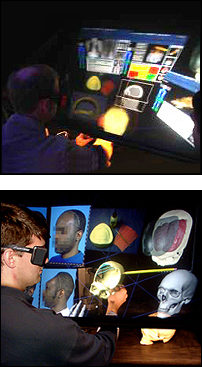Immersive Design and Fabrication of Cranial Implants on PARIS™
September 1st, 2001 - August 31st, 2006
Categories: Applications, MS / PhD Thesis, Virtual Medicine, Visualization, VR

About
The Electronic Visualization Laboratory (EVL) at the University of Illinois at Chicago (UIC) in cooperation with UIC’s Virtual Reality in Medicine Laboratory and Department of Neurosurgery, are developing a collaborative augmented reality environment with haptic feedback to provide a precise method to construct and revise pre-surgical cranial implant designs. This process can correct traumatic head injuries and restore normal facial appearance.
UIC doctors and medical modelers pioneered a method in 1996 to make custom-fitting cranial implants prior to surgery using the patient’s computed tomography (CT) data. In it, a computer model of the skull and defect is generated and sent to a rapid prototyping stereo-lithography machine to produce a physical model. This physical model then serves as a template for the sculpting, molding and casting techniques required to manufacture the actual implant.
Although this computer-assisted technique is a proven improvement over the still widely used method where the implant is fashioned in the operating room (the heat generated during the curing process often causes tissue damage), it is often prohibitively expensive because of the number of individuals and steps involved in the pre-fabrication process.
Now, using EVL’s PARIS (Personal Augmented Reality Immersive System), a surgeon and medical modeler can view a three-dimensional model of a patient’s CT data, and collaboratively review, sculpt and “virtually” build an implant using their hands. An authentic sensation of the mold sculpting process is achieved using SensAble Technologies’ PHANTOM force-feedback device.
EVL-developed software provides the collaborative capabilities to allow surgeons and medical modelers in geographically distant locations to review and revise the implants over advanced networks. Patients can also view and discuss the post surgical results beforehand.
This digital, networked, collaborative modeling environment aims to eliminate many time-consuming steps and make this surgical procedure widely available. The digital model of the implant can be exported directly to a variety of rapid-prototyping manufacturing modalities making “hands on” sculpting, molding, and casting steps unnecessary, and allowing the use of new, state-of-the-art implant materials.
PARIS system development and cranial implant research are made possible by major funding to the University of Illinois at Chicago from the National Science Foundation (NSF) Research Infrastructure award EIA-9802090 and Major Research Instrumentation award EIA-9871058, and the Department of Energy (DoE) Accelerated Strategic Computing Initiative (ASCI) program, award B519836. CAVERNsoft and Quanta are funded by NSF awards EIA-9802090, ANI-9730202, ANI-0129527 and the NSF Partnerships for Advanced Computational Infrastructure (PACI) cooperative agreement (ACI-9619019) to the National Computational Science Alliance.